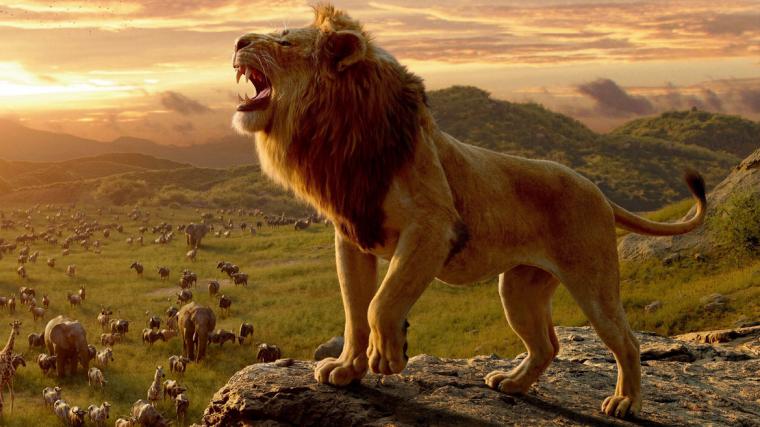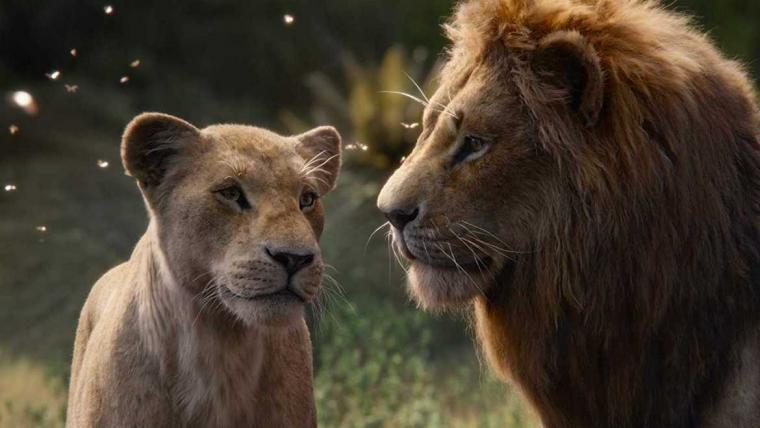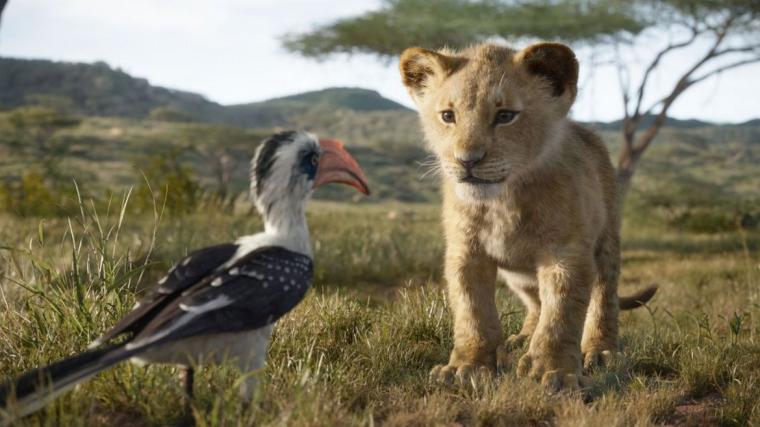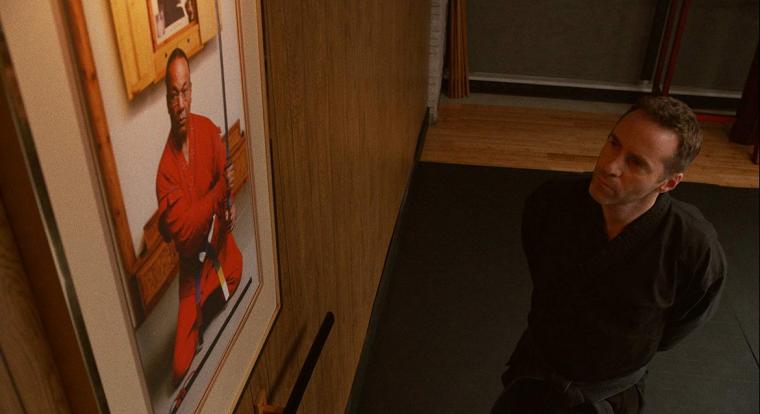
THE LION KING
At about the 90-minute mark of director Jon Favreau's two-hour remake of The Lion King, we're finally (finally!) treated to a sequence that's visually rapturous, narratively transfixing, slyly touching and funny, and thematically transcendent all at once – everything that you wish Disney's new CGI behemoth was, and isn't, on a scene-by-scene basis.
This wordless segment begins with an airborne tuft of fur once belonging to Simba, the lion prince of the African Pride Lands long thought dead yet living, and currently despondent, in the jungle. The hairball floats and flies in a gentle breeze, and finally clings to the leaf of a tall, faraway tree, where it's promptly consumed by a giraffe. A jump cut later (and thank you, Disney, for small favors), the furry patch is now among the ingredients in a tight ball of excrement, one than an intrepid dung beetle begins rolling through the savanna. The scat is eventually broken up into more manageable morsels, and a nugget with Simba's fur attached is carried along by one in a long line of Army ants. Many, many miles later, the ants pass a tree in which resides the mandrill Rafiki, the Pride Lands shaman who notices – or perhaps smells – something familiar about a particular portion of the insects' cargo. Rafiki consequently plucks the fur from its carrier's back, studies it in between bites of dinner, and comes to a startling realization: The fur is Simba's! The prince is alive!
If you're acquainted with Disney's seminal, animated, Oscar-winning Lion King (and I'm guessing most of us are), you'll likely recall a comparable sequence that lasted roughly 45 seconds and climaxed with the infectious, shrieking cackle of Robert Guillaume's Rafiki as he painted a red mane on a tree-trunk image of Simba. In Favreau's version, this plot escalation instead takes up about three or four minutes of screen time. And while it doesn't end with similar vocal ebullience, in all other ways – and this is the first and last time I'll write this – the 2019 scene is a vast improvement on its 1994 counterpart.
Like the rest of Favreau's wholly CGI outing, that furball's unanticipated journey across the African plains is visually breathtaking; considering the astoundingly realistic animals and flora and weather on display, who could have predicted that a mass of computerized ones and zeroes might ever have led to sights as wondrous as these? Yet the sequence is additionally sublime because as opposed to merely replicating a memorable movie moment from 25 years ago, as so much of this remake does, it effectively re-imagines the moment, taking what was originally a happy accident (tuft of flying fur finds its way to Rafiki) and turning it into something almost supernaturally preordained.

In Favreau's and screenwriter Jeff Nathanson's imagining, that fur would never have reached Rafiki – and Rafiki, in turn, would never have found Simba – had that giraffe not eaten (and passed) it, and had that dung beetle not rolled it toward the ant, and had that ant not carried it past the mandrill. The Lion King's opening song, as no one needs to be reminded, is “Circle of Life,” and in both cinematic takes on this tale, Simba's father Mufasa delivers to his son an eloquent speech about the circle's being and purpose. In the travels of that patch of mane, however, we find a miniaturized Circle of Life actually playing out in front of our eyes, and for a few deliriously enjoyable minutes, Favreau's blockbuster hints at how miraculous this Lion King might've been were all of it presented with this combination of technical mastery and soulful invention. That's not what we get, though. Not by a long shot.
I've read reviews of Favreau's latest that have likened it less to Disney's recent spate of live-action remakes (Beauty & the Beast, The Jungle Book, Aladdin, et al) than to Gus Van Sant's 1998 “shot-for-shot” remake of Hitchcock's Psycho, and it's an apt comparison. If there are any doubts that the film is going to be slavishly beholden to its 25-year-old precursor, they're promptly eliminated in the “Circle of Life” opener, which appears to mimic the cartoon sequence nanosecond-by-nanosecond, right down to the adorable sneeze as Rafiki dusts a royal symbol on Simba's forehead. (Unsurprisingly, the sequence also ends – as does the movie itself – with that loud musical thunderclap as the film's title is plastered on-screen.) But this is like Van Sant's Psycho if everyone in it shared the same unwavering look of passive indifference.
Felines, by nature, aren't the most facially expressive of creatures. Neither are elephants, antelope, and other four-legged denizens of the African savanna. Consequently, in their quest for the most lifelike presentation that $250 million can buy, Favreau and company are able to replicate the 1994 prelude in terms of composition, cutting, and scenic detail, but they can't replicate the feeling – at least not in ways that wouldn't destroy the intended realistic effects. So now, when Rafiki lifts the newborn Simba to the heavens in that instantly iconic imagine, we don't see the comically baffled expression of a young lion cub not yet realizing he'll one day be ruler over all that the light touches. We see a cute but typically blank-faced cub merely staring at the animal masses with no visible reaction – no hint of acknowledgment – whatsoever. The music accompanying Simba's official debut may be glorious (and that Elton John/Tim Rice tune is still awfully rousing), but Simba's and the other animals' “natural” deadpans effectively mute its power – a presentational bummer that, in one way or another, hinders the movie over and over again.
It should probably go without saying that the animals and birds in Favreau's Lion King talk and sing just like they did in 1994. But that's not entirely true. They may talk and sing, but their vacant, “realistic” visages don't reflect any emotion while the unseen vocal performers are interpreting lines and lyrics. Simba's “I Just Can't Wait to Be King” solo may still be a peppy delight, yet its pep dissipates every time the CGI “camera” catches the caterwauling Simba looking just like a normal, bored house cat. “Hakuna Matata” is an inevitable hoot, but far less of one when made inseparable from any ol' afternoon at the feeding troth. “Can You Feel the Love Tonight?” Not here you can't – not when the animated film's burgeoning romantic ardor between Simba and Nala is replaced by looks suggesting the theoretically love-swept lions could just as easily take or leave one another. For the majority of its length, most of what the film's creatures are saying and singing isn't – can't be – echoed in their faces, and the dissonance between what you're hearing and what you're seeing is distracting to no end. Watching this movie is like wandering through a zoo while listening to the Lion King soundtrack through earbuds.

Are the celebrity vocals fun, at least? Occasionally. Some might thrill to hearing James Earl Jones, with his magnificent baritone, rumble through Mufasa's lines just like he did in 1994. Forgive the blasphemy of the sentiment, though: I wish the fimmakers had gone with someone else. Whenever Jones in heard on-screen, saying the exact same things he did a quarter-century ago, it's just another reminder of how little imagination this particular Lion King possesses, and I'm sorry to say it, but the movie is never duller than when Mufasa is around. Casting Donald Glover as Jones' son certainly makes more sense than the 1994 casting of Matthew Broderick as the adult Simba (as does having Beyoncé in the Nala role that originally went to Moira Kelly), but whatever interior life the performers lend through their readings is lost in the banality of their characters' leonine lack of expression.
The more overtly comedic figures, however, fare better. I initially worried about the folly of any actors attempting to replicate the peerless vaudeville team of Nathan Lane and Ernie Sabella, whose meerkat Timon and warthog Pumbaa will forever be in a second-banana class by themselves. Yet Billy Eichner, leaning heavily into Timon's sardonic bitchiness, was solely responsible for my handful of audible laughs, and Seth Rogen, though not as funny, partnered him with stoner-comedy ease; their largely deadpanned yuks aren't entirely sabotaged by the animals' natural deadpans. (And I dug the realization that, when singing, Rogen sounded exactly like Kermit the Frog.)
Other participants – John Kani as Rafiki, John Oliver as the worrywart hornbill Zazu, Alfre Woodard as the regal lioness Sarabi – perform their vocal duties with general aplomb, while Keegan-Michael Key delivers some offhandedly nut-brain readings as the hyena Kamari … though it was somewhat disconcerting to hear his partner-in-crime voiced by Eric André and not Jordan Peele. And as it would be unfair to compare anyone's vocal performance to Jeremy Irons' mellifluously malevolent Scar from 1994, I was happy that Chiwetel Ejiofor went another route entirely, his sinister underplaying making this Shakespearean villain less overtly than insidiously evil.
Yet for all of the actors' contributions and the undeniable visual wizardry on display, I really didn't feel anything at this Lion King – not even the irritation I experienced all throughout the recent Aladdin. While Favreau's offering may be a similar cash grab, it's not an altogether cynical one; you get the sense of filmmakers truly shooting for something unprecedented and grand. And whenever the action isn't dependent on the anthropomorphizing of animals – in the climax's fiery free-for-all, for instance, or during that frightening wildebeest stampede (which, just like in 1994, still contains far too many wildebeests) – the film is just as impressive as you want it to be. But as ever, jaw-dropping technical acumen can never compensate for missing heart, and here, I was never once convinced that any of Favreau's furry and winged beings had a heart. Beyoncé contributed a new song for the soundtrack (and, no doubt, for Oscar consideration) titled “Spirit.” Yet ironically, that's ultimately what the film still finds itself without.

THE ART OF SELF-DEFENSE
Alessandro Nivola has been a steadily employed film actor, frequently in leading and major supporting roles, for more than two decades. Yet it's the damnedest thing: Nearly every time I see him on-screen – be it in Jurassic Park III or Junebug or A Most Violent Year – I think, “That guy's really good… who is he?!” I'm not sure how to account for my memory block; like the equally underrated (yet instantly recognizable) Billy Crudup, Nivola is a gifted character actor blessed with movie-star handsomeness, and it's not like his name easily blends into any kind of “Is that Bill Pullman or Bill Paxton?” pack. Maybe it's because Nivola vanishes so subtly yet so completely into whatever character he's playing – a strict Orthodox Jew in Disobedience, Louis C.K.'s boss in American Hustle – that it always feels like I'm seeing him for the very first time. In any case, I'm hoping/expecting to have no trouble identifying the performer going forward, because from now on, whenever Nivola makes his first appearance, I'll likely say to myself, “Oh, excellent! It's that guy from The Art of Self-Defense!” If, that is, I wind up remembering writer/director Riley Stearns' movie with the ease that I'll remember its chief asset.
An R-rated Karate Kid doused with a healthy dollop of Fight Club, Stearns' dark empowerment comedy finds the skinny, twitchy, awkward 35-year-old Casey (Jesse Eisenberg, natch) suffering a brutal and humiliating beating at the hands of motorcycle-riding thugs, and deciding to better himself through martial-arts training at his nearby strip-mall dojo. Nivola plays the dojo's sensei – a poker-faced, tight-lipped instructor who only answers to “Sensei” – and needless to say, neither the man nor his training center are quite what they seem. But how are they meant to seem? From the start, Stearns establishes an intensely off-putting universe that appears to exist in some generic land of the recent-ish past: Dog food comes in 50-pound bags labeled “Dog Food” and the local bar is named “Bar,” and despite other present-day trappings, there are video cassettes and answering machines where DVDs and cell phones should be. (Even these niceties are oftentimes askew: The recorded voice on Casey's answering machine tells him, “Your mailbox is full … please clear your messages,” like it's tired of reminding him.)
But long before the narrative begins to pick up (halting) momentum about halfway through, the affectation begins to feel like self-consciousness, and even the scenes you're enjoying – such as Casey's retribution on his dull-witted co-workers – feel like screenwriting conceits devised for momentary enjoyment that have nothing to do with the larger picture, whatever that might be. Even as the end credits rolled, I had no idea if I'd just seen a brutal art-house slapstick, or a commentary on modern (or recent-past?) toxic masculinity, or – given the narrative weight given to Imogen Poots' brown-belt Anna, the only woman in view – a sardonic response to #MeToo. No matter what The Art of Self-Defense is, it's a mess, if never a boring one, and watching the typically motor-mouthed Eisenberg slow his readings down to a crawl is good for some mild amusement. But the film's only true electricity and mystery come from Nivola, whose comic inscrutability suggests that Sensei is either the smartest or stupidest of men, and whose lightly confounded, stylized deliveries combined with explosions of violence make you wonder, if only on occasion, whether The Big Twist will be that Sensei is actually from Mars. The red planet should be so lucky as to have talents like Nivola around.










